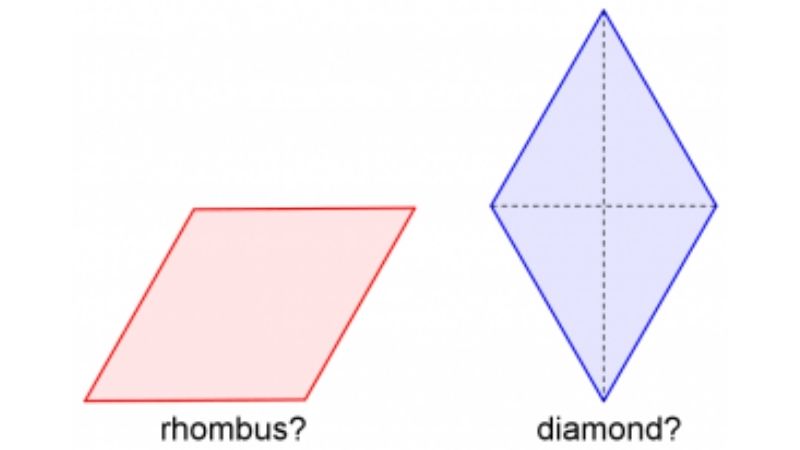Is Diamond a Rhombus?
You must have played with kites in your early days. Do you know what shape it is? Yes, it is Rhombus-shaped. The word Rhombus came from the Greek word rhombus which means spinning top.
A diamond-shaped quadrilateral with all four equal sides is called a Rhombus. Often you see Rhombus-shaped figures in our day-to-day lives.Ex: diamond, kite, etc.
Rhombus is a unique type of quadrilateral frequently referred to as diamond.
The Area of Rhombus
How do you use the area of Rhombus in daily life? I’ll give you some examples, while polishing the Rhombus-shaped tiles you need to find the area of a single tile. Using this you can find the amount of work done. It is handy in designing traffic signboards, mirrors, etc. Ex: While doing the work of the rhombus shaped mirror if you know the height is 5 cm and side length is 2 cm, you can calculate the area of the mirror by just multiplying it. Area of the Rhombus shaped mirror = 10 cm2
Finding the Area of Rhombus
The area of a Rhombus is a space enclosed by a Rhombus in a two-dimensional plane. You can calculate it in three different ways, depending on the given parameters.
The different methods that you can use to calculate the area of a Rhombus are,
- Base and height – b X h sq units
- Diagonals – (d1 x d2) / 2 sq. units
- Trigonometry – l2 X sin(P)
When only Base and Height of Rhombus are Known
As you know Rhombus is a parallelogram. So similar to a parallelogram you can find the area of a Rhombus by multiplying its base and height in sq units.
Area of a Rhombus = b X h sq units
where b = Base and h = Height
Example: If you know the base of the Rhombus is 4 cm and height is 6 cm,
then the area of the Rhombus = 4 cm X 6 cm = 24 cm2
When length of Diagonals in a Rhombus are Known
If you know the length of the diagonals, then the area of Rhombus is a product of its diagonal lengths divided by 2.
So, Area of the Rhombus = (d1 x d2) / 2 sq. units.
Where d1 and d2 are lengths of diagonals of the Rhombus.
Example: Let the length of the diagonals be 4 and 5 cm respectively.
Then, Area of the Rhombus = (4 X 5)/2 = 10 cm2
When Side and Angles Are Known
You apply the concept of trigonometry in this case. Here any angle or side length can be used because they are either supplementary or equal. So, the Area of the Rhombus is equal to the square of any side length multiplied by the sine of the angle between any sides.
Area of a Rhombus = l2 X sin(P)
Where l = length of the side and P = Angle between the sides
Ex. Let the length of the side as 4 cm and angle subtended as 300
Then, Area of Rhombus = l2 X sin(P) = 16 X sin 300
Area of Rhombus = 16/2 = 8 cm2
Do You Know the Properties of the Rhombus?
Rhombus properties are similar to that of parallelograms. Some of them are,
- All four sides are equal along with parallel opposite sides.
- Opposite angles are congruent.
- The diagonals bisect at right angles.
- The sum of two adjacent angles is 1800.
This is all about Rhombus and its area calculation. Isn’t it useful for you?
Now you ask the difference between Rhombus and a square?
- A square has got all equal angles and perpendicular sides, whereas in rhombus only opposite angles are equal and parallel.
- The diagonals are of equal length in a square but they are unequal in Rhombus.
- You can inscribe a square in a circle but not the Rhombus.
- Four lines are symmetrical in squares whereas in the latter case only two are symmetrical.
Let’s end it here. For still more interesting information log on to cuemath website and get yourself loaded with the knowledge.










